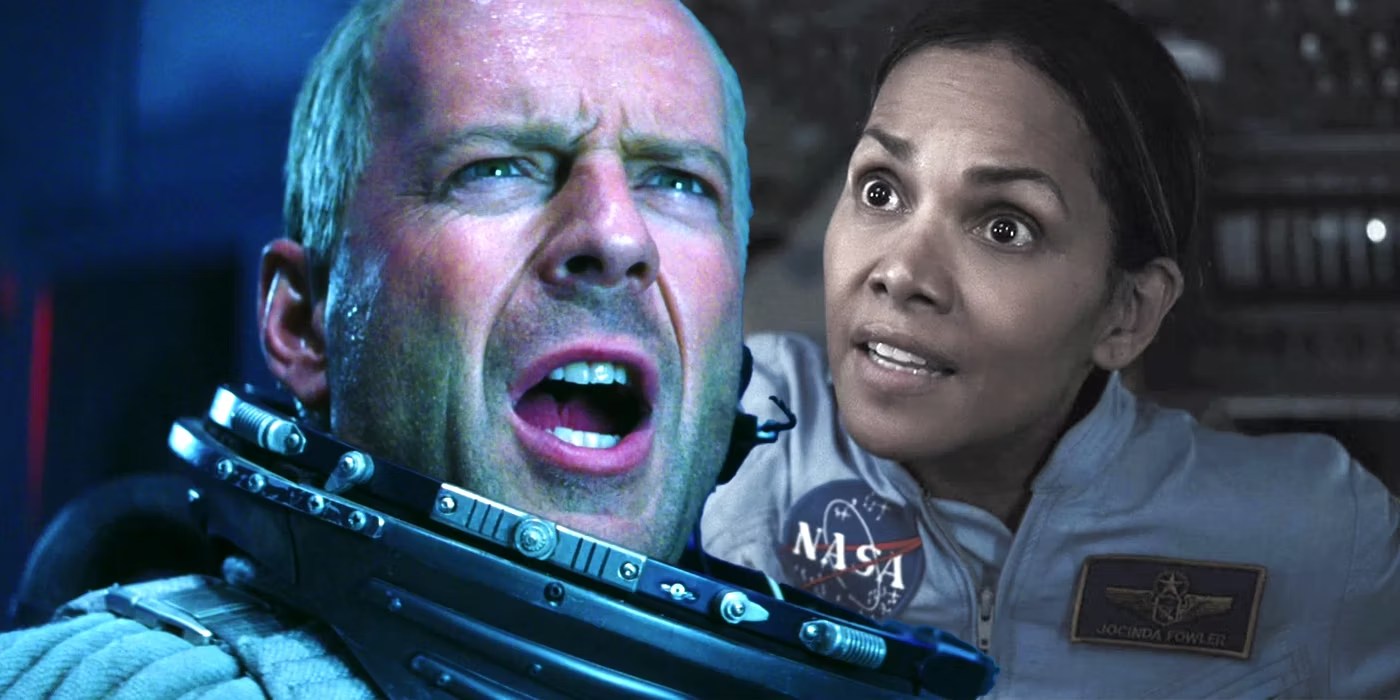Armageddon (1998)

Armageddon (1998), directed by Michael Bay and produced by Jerry Bruckheimer, is a quintessential example of the disaster film genre, blending high-octane action with emotional depth and heroic undertones. With its explosive set pieces, star-studded cast, and sweeping narrative, the film captures the imagination of audiences and delivers a potent mix of spectacle and sentimentality. As a significant entry in the late 1990s’ wave of disaster cinema, Armageddon combines thrilling visual effects with themes of sacrifice, courage, and teamwork.
Armageddon centers around a catastrophic threat to Earth posed by a massive asteroid on a collision course with the planet. The story begins with NASA discovering the asteroid, named “Dottie,” and determining that it is large enough to cause global extinction if it impacts Earth. To prevent this apocalyptic scenario, NASA devises a daring plan to drill into the asteroid and detonate a nuclear bomb, thereby diverting its trajectory and saving humanity.
The film’s narrative follows Harry Stamper (Bruce Willis), a seasoned oil driller and leader of a group of roughneck drillers. Stamper is recruited by NASA to lead a mission to space, drilling into the asteroid’s surface to plant the bomb. Accompanying him are his crew, including A.J. Frost (Ben Affleck), who is also romantically involved with Stamper’s daughter, Grace (Liv Tyler). The film details the preparation for the mission, the journey to space, and the intense challenges the crew faces as they undertake their perilous task.

Bruce Willis’s portrayal of Harry Stamper is central to the film’s emotional and dramatic core. Willis brings a combination of rugged determination and heartfelt vulnerability to the role of the seasoned driller who must confront both personal and existential stakes. Stamper’s role as a father and leader adds depth to the character, making his ultimate sacrifice both poignant and impactful.
Ben Affleck’s performance as A.J. Frost provides a youthful counterpoint to Willis’s character. A.J. is portrayed as an ambitious and passionate individual who proves his worth through bravery and selflessness. His relationship with Grace adds a personal stake to the mission, highlighting themes of love and commitment amidst the chaos.
Liv Tyler, as Grace Stamper, plays the role of the determined and supportive daughter. Her character’s emotional journey reflects the personal sacrifices and familial bonds that underpin the film’s narrative. Tyler’s performance contributes to the film’s emotional resonance, particularly in the scenes that explore the impact of the mission on those left behind.
The supporting cast, including Steve Buscemi, William Fichtner, and Owen Wilson, deliver memorable performances that enhance the film’s ensemble dynamic. Their characters, ranging from eccentric to stoic, add humor and depth to the narrative, balancing the film’s intense action with moments of levity and camaraderie.
Armageddon explores several themes that resonate with audiences, including sacrifice, courage, and the power of human resilience. The central theme of sacrifice is embodied by the characters’ willingness to risk their lives for the greater good. The film emphasizes the personal and collective costs of heroism, particularly through Stamper’s ultimate decision to stay behind and ensure the success of the mission.
Courage is another significant theme, as the characters face overwhelming odds and life-threatening challenges. The film portrays the crew’s bravery in the face of danger, underscoring the human spirit’s capacity to overcome adversity through determination and teamwork.
The film also highlights the theme of redemption and personal growth. Characters such as A.J. Frost demonstrate the potential for personal transformation and proving oneself in the face of crisis. The journey from skepticism and self-doubt to heroism and sacrifice is central to the film’s narrative arc.

Armageddon is renowned for its visual and technical achievements, particularly its impressive special effects and action sequences. The film’s depiction of space travel and asteroid destruction is marked by groundbreaking CGI and practical effects that create a visually stunning experience. The film’s visual spectacle, from the immense asteroid to the dramatic spacewalks, is a testament to the technological advancements of the time.
Michael Bay’s direction ensures that the film’s action sequences are both exhilarating and meticulously choreographed. The use of dynamic camera angles and fast-paced editing heightens the sense of urgency and intensity, immersing the audience in the film’s high-stakes scenarios.
The film’s musical score, composed by Trevor Rabin, adds to the emotional impact and dramatic tension. The score’s use of orchestral and rock elements complements the film’s action and emotional beats, enhancing the overall cinematic experience.

Armageddon was a commercial success, grossing over $550 million worldwide and becoming one of the highest-grossing films of 1998. Despite mixed critical reviews, the film was praised for its visual effects and engaging action sequences. It became a defining example of late 1990s disaster cinema and contributed to the popularity of the genre.
The film’s impact extends beyond its immediate success, influencing subsequent disaster and action films. Its blend of spectacle, sentimentality, and star power has left a lasting impression on audiences and filmmakers alike.
Armageddon (1998) is a memorable and exhilarating film that captures the essence of late 20th-century disaster cinema. Through its compelling characters, high-stakes action, and themes of sacrifice and bravery, the film delivers an unforgettable cinematic experience. Michael Bay’s direction, combined with impressive visual effects and a strong ensemble cast, ensures that Armageddon remains a standout entry in the genre and a testament to the power of human resilience in the face of catastrophic challenges.











